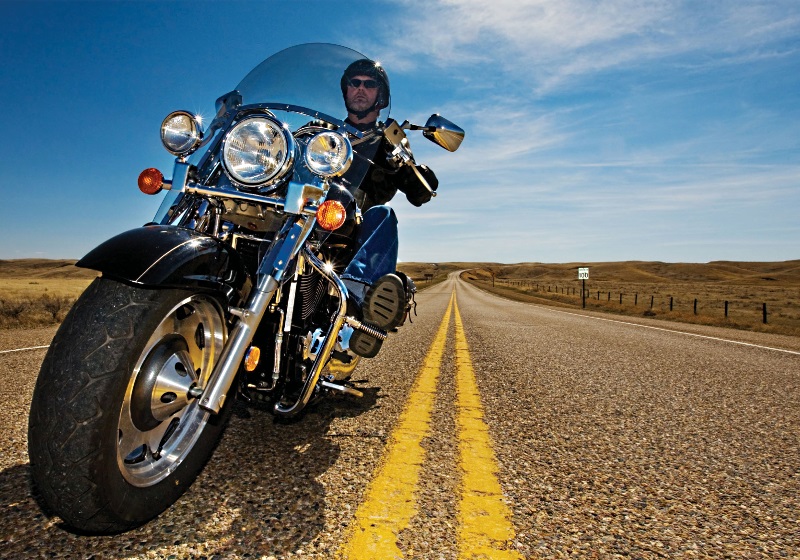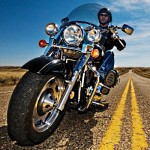
Easy Rider, Motorcyclists and motorists – have each other’s backs this summer
by Alyssa LaFaro
In June, off-duty police officer Milan Merke was taking part in a Midnight Run for Peace with the motorcycle group Men United for a Better Philadelphia.
Their goal was to create awareness and prevent violence in the city. Over the years, the group has organized rides involving hundreds of motorcyclists through the most dangerous neighborhoods of Philadelphia.
This ride would be Merke’s last. An SUV made a left-hand turn into his path and they collided, reported Philadelphia news station WPVI-TV. Eight days later, Merke passed away. He was 28 years old.

More than 50 percent of motorcycle accidents involve collisions with another vehicle, according to the Motorcycle Safety Foundation. In a majority of these accidents, the driver of the other vehicle (not the motorcyclist) violated the motor cycle right-of-way, causing the accident to occur. It’s important to remember that all parties should always take caution – the motorcyclists and the motorists that share the roads with them.
If you are a motorcyclist, you need to be visible, aware of your surroundings, and know how to use your bike. Lights, reflective strips/decals, bright clothing and your horn are all preventative ways to make sure you are seen and heard. You should also give yourself time to respond to the actions of other drivers, ride in the part of the lane where you are most visible and use your signals in advance before turning. Practice makes perfect, so establish your riding techniques before entering an eight-lane highway and learn to stick to the speed limit.
If you don’t ride a motorcycle, you have a different set of rules. Here are some tips from the Motorcycle Safety Foundation to help you be more aware of motorcycles on the road.
- Because of its small size, a motorcycle can be easily hidden in a car’s blind spots (door/roof pillars) or masked by objects or backgrounds outside a car (bushes, fences, bridges, etc.). Take an extra moment to look for motorcycles, whether you’re changing lanes or turning at intersections.
- A motorcycle may look farther away than it is. It may also be difficult to judge a motorcycle’s speed. When checking traffic to turn at an intersection or into (or out of) a driveway.
- Motorcyclists often slow down by downshifting or merely rolling off the throttle, thus not activating the brake light. Allow more following distance, say three or four seconds, and at intersections, predict a motorcyclist may slow down without visual warning.
- Motorcyclists often adjust position within a lane to be seen more easily and to minimize the effects of road debris, passing vehicles and wind. Understand that motorcyclists adjust lane position for a purpose, not to be reckless, or show off or to allow you to share the lane with them.
- Turn signals on a motorcycle usually are not self-canceling. Some riders (especially beginners) sometimes forget to turn them off after a turn or lane change. Be aware that this occurs.
- Maneuverability is one of a motorcycle’s better characteristics, especially at slower speeds and with good road conditions, but don’t expect a motorcyclist to be able to dodge out of your way.
- Stopping distance for motorcycles is nearly the same as for cars, but slippery pavement makes stopping quickly difficult. Allow more following distance behind a motorcycle because it can’t always stop “on a dime.”
- When a motorcycle is in motion, see more than the motorcycle – see the person under the helmet, who could be your friend, neighbor, or relative.
Shield Yourself
Wear this gear to stay alive
- Helmet. What’s life without a brain? Nonexistent. So wear a helmet and protect your thinking cap.
Protects against: head injury, windblast, cold, flying objects - Face shield. Unless you want a mouthful of bugs for dinner, wear your face shield.
Protects against: irritated eyes, windblast, stones, insects, debris - Gloves. Wear these if you ever want to give another high-five again.
Protects against: cold temperatures, abrasion - Jacket and pants. Just remember – if you get thrown off that bike, it’s your skin versus the pavement. Dress for the ride and the crash.
Protects against: sunburn, dehydration, hypothermia, abrasion - Boots. You don’t want your flip flops getting stuck to the foot petals. Plus – other riders in your circle will probably make fun of you. Boot up.
Protects against: foot and ankle injuries








Leave a Reply
You must be logged in to post a comment.